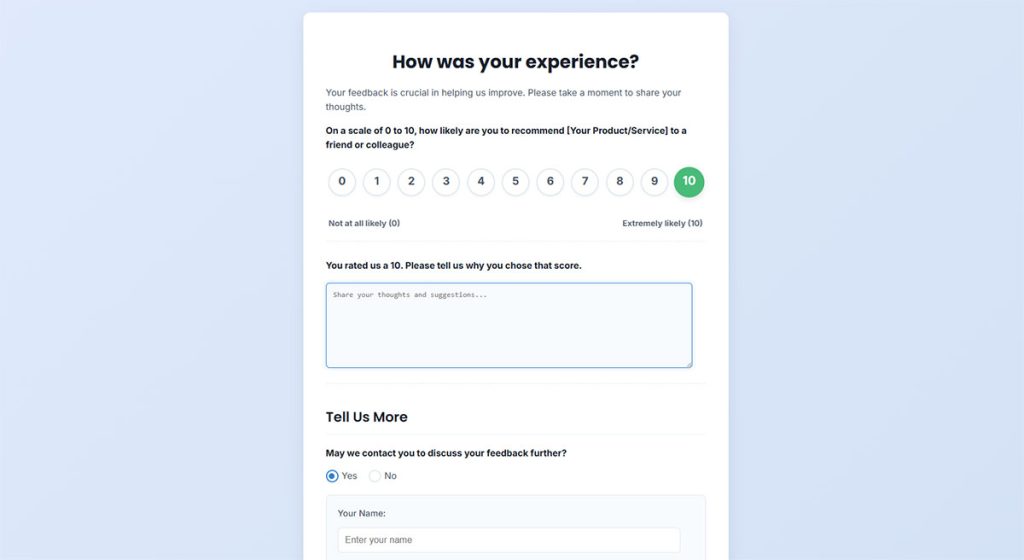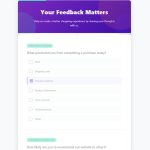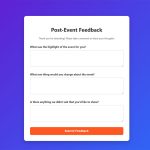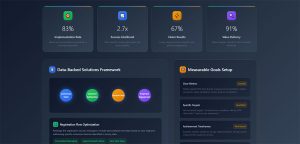One badly worded question can ruin months of research work. Every survey researcher learns this the hard way. Getting good data comes down to picking the right types of survey…
Table of Contents
Customer feedback drives business success, and Net Promoter Score (NPS) has become the gold standard for measuring customer loyalty. Crafting effective NPS survey questions transforms casual buyers into brand advocates while identifying pain points before they impact your bottom line.
Understanding the mechanics of NPS goes beyond simple satisfaction metrics. The 0-10 rating scale pioneered by Fred Reichheld categorizes respondents as promoters, passives, or detractors, providing actionable customer insights that directly correlate with growth potential.
Creating impactful survey form questions requires more than copying templates. This guide explores NPS survey best practices, from survey form templates to response segmentation strategies. You’ll learn to craft questions that generate meaningful feedback, avoid survey fatigue, and implement form validation for reliable data.
Whether you’re implementing your first NPS program or refining existing feedback forms, these techniques will help you capture voice of customer insights that drive real business decisions.
NPS Survey Questions
How likely are you to recommend our product/service to a friend or colleague? (0-10 scale)
Follow-up Questions
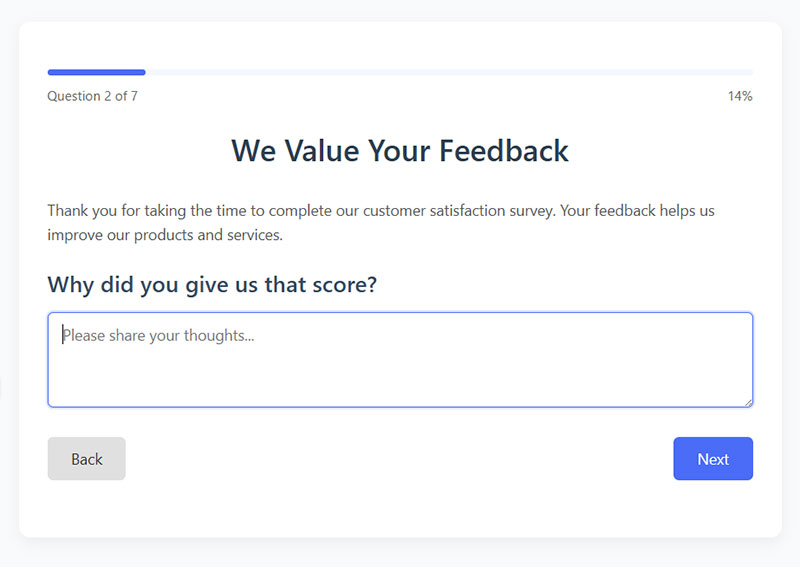
Reason for Score
Question: Why did you give us that score?
Type: Open-ended text field
Purpose: Captures qualitative feedback explaining the numerical rating, providing context for the NPS score.
When to Ask: Immediately after the core NPS question.
Improvement Area
Question: What’s one thing we could improve?
Type: Open-ended text field
Purpose: Identifies specific pain points or opportunities for enhancement from the customer’s perspective.
When to Ask: After the core NPS question to capture actionable feedback.
Most Valuable Feature
Question: Which feature brings you the most value?
Type: Open-ended text field or dropdown with feature list
Purpose: Highlights product strengths and identifies which features drive customer satisfaction.
When to Ask: Mid-survey after establishing their overall sentiment.
Initial Problem
Question: What problem were you trying to solve when you chose us?
Type: Open-ended text field
Purpose: Reveals customer jobs-to-be-done and checks if your product is solving their core needs.
When to Ask: In the middle section of the survey to understand initial motivations.
Recommendation Factors
Question: What would make you more likely to recommend us?
Type: Open-ended text field
Purpose: Identifies gaps between current and ideal experience that would turn customers into promoters.
When to Ask: After the core NPS question for detractors and passives.
Expectations Match
Question: Did our product meet your expectations?
Type: Multiple choice (Exceeded expectations, Met expectations, Somewhat met expectations, Did not meet expectations)
Purpose: Measures expectation alignment and potential satisfaction gaps.
When to Ask: Early in the survey to establish overall impression.
Alternatives Considered
Question: What alternative solutions did you consider?
Type: Open-ended text field or multi-select with common competitors
Purpose: Reveals competitive landscape and your unique selling points compared to alternatives.
When to Ask: Mid-survey to understand competitive positioning.
Ease of Use Rating
Question: How easy was our product to use?
Type: Multiple Choice (1-5 scale from “Very difficult” to “Very easy”)
Purpose: Measures perceived usability and identifies potential friction points.
When to Ask: After customers have used the product for some time.
Desired Feature
Question: What feature do you wish we had?
Type: Open-ended text field
Purpose: Reveals unmet needs and potential product roadmap priorities.
When to Ask: Mid to late survey to capture feature requests.
Retention Reason
Question: What’s the main reason you continue using our product?
Type: Open-ended text field
Purpose: Identifies core value proposition from customer perspective and retention drivers.
When to Ask: After establishing usage patterns, mid-survey.
Segment-specific Questions
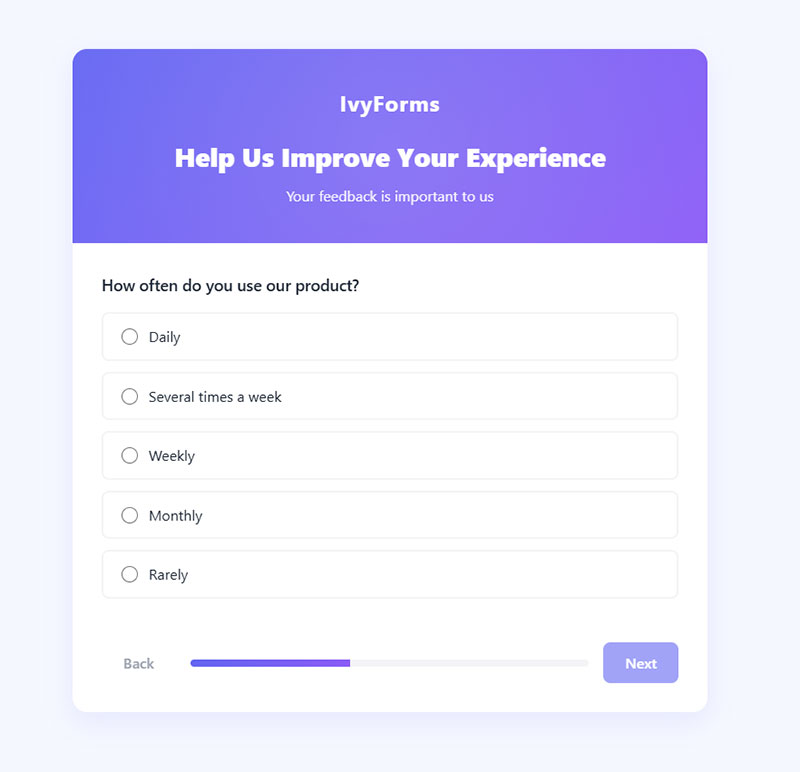
Usage Frequency
Question: How often do you use our product?
Type: Multiple choice (Daily, Several times a week, Weekly, Monthly, Rarely)
Purpose: Segments users by engagement level and helps correlate satisfaction with usage patterns.
When to Ask: Early in the survey to establish usage context.
Team Usage
Question: Which team or department uses our product most?
Type: Multiple choice (Marketing, Sales, Product, IT/Tech, Customer Support, etc.)
Purpose: Identifies which business functions find the most value in your product.
When to Ask: Early in the survey for segmentation purposes.
Primary Goal
Question: What’s your primary goal when using our product?
Type: Multiple choice or open-ended text field
Purpose: Reveals use cases and helps segment users by intent.
When to Ask: Early in the survey to understand context.
Objectives Achievement
Question: Has our product helped you achieve your objectives?
Type: Multiple choice (Yes, completely; Yes, partially; No, not really; No, not at all)
Purpose: Measures perceived value and overall success from the customer’s perspective.
When to Ask: Mid-survey after establishing their goals.
Missing Elements
Question: What’s missing from our current offering?
Type: Open-ended text field
Purpose: Identifies gaps in your product offering and potential expansion opportunities.
When to Ask: Later in the survey after customers have shared their experience.
Organization Users
Question: How many people in your organization use our product?
Type: Multiple choice ranges (1-5, 6-20, 21-50, 51-100, 101+)
Purpose: Segments by deployment size and identifies expansion opportunities.
When to Ask: Early to mid-survey for segmentation.
Industry
Question: Which industry are you in?
Type: Dropdown with common industries
Purpose: Segments customers by industry to identify vertical-specific insights.
When to Ask: Early in the survey for segmentation.
Job Role
Question: What’s your job role or title?
Type: Open-ended text field or dropdown with common roles
Purpose: Segments by persona and helps understand who uses your product.
When to Ask: Early in the survey for segmentation.
Organization Size
Question: How large is your organization?
Type: Multiple choice (1-10, 11-50, 51-200, 201-1000, 1000+ employees)
Purpose: Segments by company size to identify patterns in different market segments.
When to Ask: Early in the survey for segmentation.
Feature Usage
Question: Which specific features do you use most frequently?
Type: Multi-select checkbox with common features
Purpose: Identifies which features drive the most engagement and value.
When to Ask: Mid-survey after establishing overall usage.
Customer Experience Questions
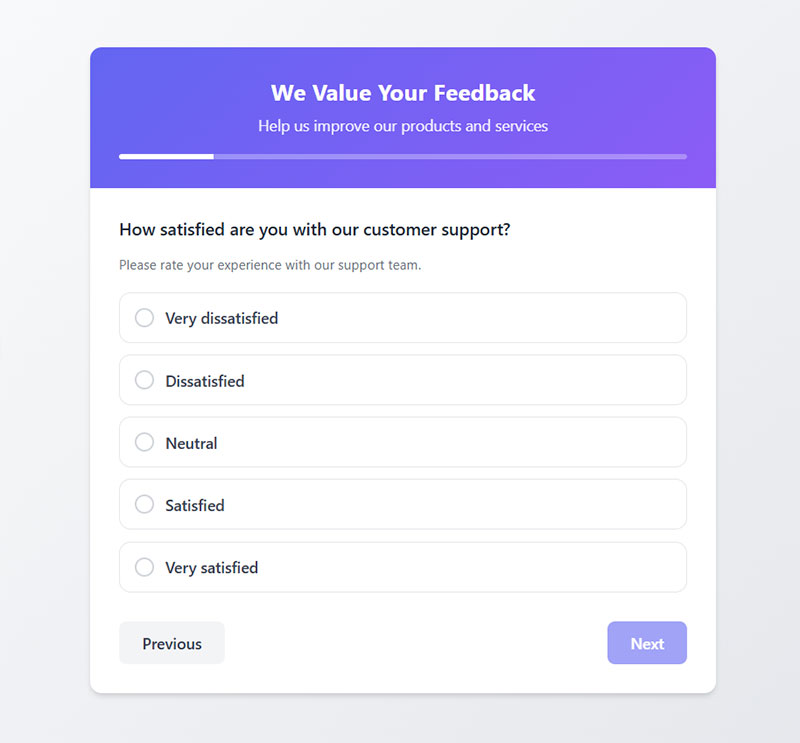
Support Satisfaction
Question: How satisfied are you with our customer support?
Type: Multiple Choice (1-5 scale from “Very dissatisfied” to “Very satisfied”)
Purpose: Measures satisfaction with support experience and identifies service gaps.
When to Ask: Mid to late survey after establishing product experience.
Onboarding Experience
Question: Was it easy to get started with our product?
Type: Multiple Choice (1-5 scale from “Very difficult” to “Very easy”)
Purpose: Evaluates the clarity and effectiveness of your onboarding process.
When to Ask: Early to mid-survey, especially for newer customers.
Value for Money
Question: How would you rate the value for money of our product?
Type: Multiple Choice (1-5 scale from “Poor value” to “Excellent value”)
Purpose: Measures perceived value relative to cost and identifies pricing concerns.
When to Ask: Later in the survey after establishing overall satisfaction.
Pain Points
Question: What frustrated you most during your experience?
Type: Open-ended text field
Purpose: Identifies specific friction points and improvement opportunities.
When to Ask: Mid to late survey after customers have shared positive feedback.
Change Request
Question: If you could change one thing about our product, what would it be?
Type: Open-ended text field
Purpose: Forces prioritization of improvements from the customer perspective.
When to Ask: Late in the survey after customers have shared overall feedback.
Support Responsiveness
Question: How responsive has our support team been to your needs?
Type: Multiple Choice (1-5 scale from “Not responsive” to “Extremely responsive”)
Purpose: Evaluates speed and effectiveness of support interactions.
When to Ask: For customers who have contacted support.
Onboarding Helpfulness
Question: Did you find our onboarding process helpful?
Type: Multiple Choice (Yes, Somewhat, No)
Purpose: Evaluates the effectiveness of your user onboarding experience.
When to Ask: For newer customers who have completed onboarding.
Interface Intuitiveness
Question: How intuitive is our user interface?
Type: Multiple Choice (1-5 scale from “Very confusing” to “Very intuitive”)
Purpose: Measures perceived ease of use and identifies UX improvement opportunities.
When to Ask: After customers have used the product for some time.
Technical Issues
Question: Have you experienced any technical issues? If yes, please describe.
Type: Yes/No with conditional text field
Purpose: Identifies bugs, performance issues, or technical barriers.
When to Ask: Mid to late survey to capture technical feedback.
Resolution Speed
Question: How quickly were your problems solved?
Type: Multiple Choice (1-5 scale from “Very slowly” to “Very quickly”)
Purpose: Measures support efficiency and effectiveness.
When to Ask: For customers who have reported issues.
Closing Questions

Contact Permission
Question: May we contact you to discuss your feedback further?
Type: Yes/No with conditional contact information fields
Purpose: Enables follow-up for clarification or deeper insights on specific feedback.
When to Ask: At the end of the survey.
Additional Feedback
Question: Is there anything else you’d like to share?
Type: Open-ended text field
Purpose: Captures any feedback not covered by previous questions.
When to Ask: At the very end of the survey.
Testimonial Willingness
Question: Would you be willing to provide a testimonial?
Type: Yes/No
Purpose: Identifies potential customer advocates for marketing purposes.
When to Ask: At the end of the survey for promoters (high NPS scores).
Research Participation
Question: Would you participate in a user research session?
Type: Yes/No with conditional availability fields
Purpose: Builds a panel of research participants for future product testing.
When to Ask: At the end of the survey.
Survey Improvement
Question: How can we make this survey more useful to you?
Type: Open-ended text field
Purpose: Improves future survey effectiveness and shows you value their input.
When to Ask: At the very end of the survey.
FAQ on NPS Survey Questions
What is the standard NPS question format?
The standard question is “How likely are you to recommend our company/product/service to a friend or colleague?” followed by a 0-10 scale. This core question, developed by Bain & Company, measures customer loyalty through recommendation likelihood. Most survey form templates include this exact wording to maintain benchmark comparability.
How often should I send NPS surveys?
Timing varies by business type. For transactional NPS, send immediately after purchase or interaction. For relationship NPS, quarterly surveys work for B2B companies while B2C businesses might survey biannually. Avoid survey fatigue by spacing surveys appropriately and using conditional logic to show relevant questions.
What follow-up questions should I include?
Add one open-ended question asking why respondents gave their score. This qualitative feedback provides context behind the numbers. Consider adding customer experience questions for specific touchpoints. Keep follow-ups brief, relevant and use form design principles to encourage completion.
How do I calculate my NPS score?
Subtract the percentage of detractors (0-6) from the percentage of promoters (9-10). For example: 60% promoters – 20% detractors = +40 NPS. Passives (7-8) aren’t counted in this calculation but provide valuable insights. Most feedback form templates include automatic scoring functionality.
What’s a good NPS score?
Any positive score (above 0) means more promoters than detractors. Industry benchmarks vary widely, so compare against competitors using Satmetrix industry reports. The global average hovers around +32, but top performers like Apple and Tesla achieve +70. Focus on improving your score rather than hitting arbitrary targets.
Should I customize the standard NPS question?
Slight modifications are acceptable but maintain the recommendation framing and 0-10 scale for benchmark compatibility. Creating conversational forms can improve engagement. Product-specific NPS may replace “company” with your product name, but dramatic rewording compromises score validity.
How can I increase NPS survey response rates?
Keep surveys brief, optimize timing, and use mobile forms for convenience. Clear placeholder text improves completion rates. Personalize invitations, explain the purpose, and consider incentives for participation. A compelling form submission confirmation message can encourage future participation.
How should I segment NPS responses?
Break down results by customer demographics, product lines, and customer journey stages. Segmentation reveals which customer groups have the best experience. Use form builder with conditional logic to customize follow-up questions based on score ranges, extracting deeper insights from each segment.
What’s the difference between NPS and CSAT?
NPS measures long-term loyalty through likelihood to recommend, while CSAT (Customer Satisfaction Score) gauges immediate satisfaction with specific interactions. NPS predicts growth through word-of-mouth while CSAT identifies immediate issues. Many businesses use both metrics alongside post-purchase survey questions for comprehensive feedback.
How do I act on NPS feedback?
Follow up with detractors quickly to resolve issues. Study promoter feedback to identify strengths. Establish a closed-loop process where feedback triggers specific actions. Use web forms to collect additional information when needed. Report results to all departments and integrate insights into product development and customer success strategies.
Conclusion
Effective NPS survey questions transform customer feedback into actionable insights that drive retention and growth. By implementing the strategies outlined in this guide, you’ll create surveys that generate valuable response data while maintaining high participation rates.
Remember these key takeaways:
- Keep it simple – The core NPS question remains powerful in its simplicity
- Context matters – Use types of popups and landing page forms strategically based on customer journey stage
- Always follow up – Create a closed feedback loop that turns insights into improvements
Improving your form UX design and implementing multi-step forms can significantly impact completion rates. When combined with proper form accessibility practices and strategic deployment through WordPress survey plugins, your NPS program becomes a powerful competitive benchmarking tool.
The journey to customer experience excellence is continuous. Start measuring, start improving.
